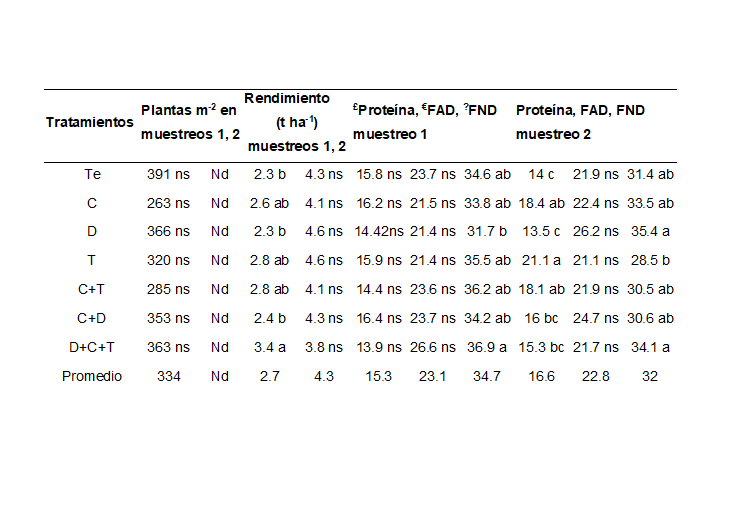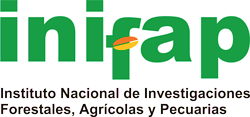Trichoderma spp. evaluation, disinfestation and soil chiseling in alfalfa
DOI:
https://doi.org/10.29312/remexca.v16i5.3082Keywords:
diseases, endophytes, forages, fungiAbstract
Crops of alfalfa Medicago sativa L. are limited by crown rot (Rhizoctonia solani), Texas root rot (Phymatotrichopsis omnivora) and soil salinity and compaction. To attenuate crop rots, the objectives were, at the laboratory level, to evaluate methods of inoculation of Trichoderma spp. in alfalfa seed and in the field, to evaluate agronomic parameters, crown rot and Texas root rot after inoculating the seed with T. harzianum (T), deep soil chiseling (C) and reductive soil disinfestation (D), the combinations C+T, C+D, D+C+T, and uninoculated seed and untreated soil as the control (Co). Dishes (PDA) of T. harzianum of 1, 2, 4, 8 and 10 d of growth were used to place previously germinated (GS) or non-germinated (NGS) alfalfa seeds; after 17 d, the size and survival of the NGS seedlings was greater than their corresponding GS (Tukey p< 0.05). In the field, the weight and size of D+C+T vs. Co plants were between (27-35) and (9-3)% higher, respectively, but without statistical significance. Only in the first sampling, a 30% higher yield of D+C+T was detected when compared to Co (Tukey p= 0.05). The quality, yield and plants per m2 of alfalfa were similar to what had been previously reported.
Downloads
References
Bilal, S.; Shahzad, R.; Imran, M.; Jan, R.; Kim, K. M. and Lee, I. J. 2020. Synergistic association of endophytic fungi enhances Glycine max L. resilience to combined abiotic stresses: Heavy metals, high temperature and drought stress. Industrial Crops and Products. 143:1-10. https://doi.org/10.1016/j.indcrop.2019.111931.
Bonanomi, G.; Antignani, V.; Pane, C. and Scala, F. 2007. Suppression of soilborne fungal diseases with organic amendments. Journal of Plant Pathology. 89(3):311-324. https://www.jstor.org/stable/41998409.
Chavez, H. B.; Bloss, H. E.; Boyle, A. M. and Gries, G. A. 1976. Effects of crop residues in soil on Phymatotrichum root rot of cotton. Mycopathologia. 58(1):1-7. https://link.springer.com/article/10.1007/BF00493585.
Chew-Madinaveitia, Y. y Samaniego-Gaxiola, J. A. 2007. Tratamiento a la semilla de alfalfa Medicago sativa L. con Trichoderma sp. para el manejo de Rhizoctonia solani y Fusarium spp. Agrofaz. 7(1):51-56. http://agrofaz.net/index.php/agrofaz.
Chew-Madinaveitia, Y. and Santamaría-César, J. 2000. Estimation of losses caused by crown rot of alfalfa Medicago sativa L. in the Comarca Lagunera North of Mexico. ITEA. Información Técnica Económica Agraria. 96(3):165-172. https://www.aida-itea.org/aida-itea/files/itea/revistas/2000/96V-3/96V-3-02.pdf.
Figueiredo dos Santo, L.; Fernandes-Souta, J.; Paula-Soares, C.; Oliveira-Rocha, L.; Luiza, Carvalho-Santos, M.; Grativol-Gaspar, C.; Fernando-Wurdig, R. L. and Lopes-Olivares, F. 2021. Insights into the structure and role of seed-borne bacteriome during maize germination. FEMS Microbiology Ecology. 97(4):1-13. http://orcid.org/0000-0001-6541-0324.
Harman, G. E.; Doni, F.; Khadka, R. B. and Uphoff, N. 2021. Endophytic strains of Trichoderma increase plants' photosynthetic capability. Journal of applied microbiology. 130(2):529-546. https://doi.org/10.1111/jam.14368.
Kasuya, M.; Olivier, A. R.; Ota, Y.; Tojo, M.; Honjo, H. and Fukui, R. 2006. Induction of soil suppressiveness against Rhizoctonia solani by incorporation of dried plant residues into soil. Phytopathology. 96(12):1372-1379. https://doi.org/10.1094/PHYTO-96-1372.
Lara-Macías, C. R. y Jurado-Guerra, P. 2014. Paquete tecnológico para producir alfalfa en el estado de Chihuahua. Centro de Investigación Regional Norte Centro- Instituto Nacional de Investigaciones Forestales, Agrícolas y Pecuarias (INIFAP). Chihuahua, México. Folleto técnico núm. 52. 48 p. https://www.producechihuahua.org/paqs/PT-0010Alfalfa.pdf.
Lata, R.; Chowdhury, S.; Gond, S. K. and White, J. F. 2018. Induction of abiotic stress tolerance in plants by endophytic microbes. Letters in applied microbiology. 66(4):268-276. https://sfamjournals.onlinelibrary.wiley.com/doi/full/10.1111/lam.12855.
Mayer, K. M. 2002. Impact of nitrogen management strategies on yield, N-use efficiency, and Rhizoctonia diseases of Irish potato. A thesis North Carolina State University Master of Science. 90 p. https://repository.lib.ncsu.edu/bitstream/handle/1840.16/113/etd.pdf?sequence=1&isAllowed=y.
Moin, S.; Rahman, A.; Parveen, G.; Korejo, F.; Shafique, H. A.; Zehra, R. and Ehteshamul-Haque, S. 2021. Amelioration of systemic resistance in tomato against root rotting fungi by the endophytic Trichoderma species. Pakistan Journal of Botany. 53(1):321-327. http://www.pakbs.org/pjbot/papers/1610615318.pdf.
Morán-Diez, M. E.; Martínez-Alba, Á. E.; Rubio, M. B.; Hermosa, R. and Monte, E. 2021. Trichoderma and the plant heritable priming responses. Journal of Fungi. 7(4):318-341. https://www.mdpi.com/2309-608X/7/4/318/pdf.
Mukhopadhyay, A. N.; Shrestha, S. M. and Mukherjee, P. K. 1992. Biological seed treatment for control of soil-borne plant pathogens. Boletín Fitosanitario de la FAO. 21-32 pp. https://agris.fao.org/agris-search/search.do?recordID=XF9432035.
Núñez, H. G. 2000. Valor nutritivo de la alfalfa. In: producción y utilización de la alfalfa en la zona norte de México. INIFAP. Matamoros, Coahuila, México. Libro técnico núm. 2. 93-102 pp. http://www.inifap-nortecentro.gob.mx/include/container-usuario.php.
Papavizas, G. C.; Adams, P. B.; Lumsden, R. D.; Lewis, J. A.; Dow, R. L.; Ayers, W. A. and Kantzes, J. G. 1975. Ecology and epidemiology of Rhizoctonia solani in field soil. Phytopathology. 65(8):871-877. https://www.apsnet.org/publications/phytopathology/backissues/Documents/1975Articles/Phyto65n08-871.pdf.
Redman, R. S.; Kim, Y. O.; Cho, S.; Mercer, M.; Rienstra, M.; Manglona, R. and Rodriguez, R. J. 2021. A Symbiotic approach to generating stress tolerant crops. Microorganisms. 9(5):920-947. https://www.mdpi.com/2076-2607/9/5/920/pdf.
Rohweder, D.; Barnes, R. F. and Jorgensen, N. 1978. Proposed hay grading standards based on laboratory analyses for evaluating quality. Journal of Animal Science. 47(3):747-759. https://doi.org/10.2527/jas1978.473747x.
Rokni, N.; Alizadeh, H. S.; Bazgir, E.; Darvishnia, M. and Mirzaei-Najafgholi, H. 2021. The tripartite consortium of Serendipita indica, Trichoderma simmonsii, and bell pepper (Capsicum annum). Biological Control. 158(7):1-12. https://doi.org/10.1016/j.biocontrol.2021.104608.
Rush, C. M. and Lyda, S. D. 1984. Evaluation of deep-chiseled anhydrous ammonia as a control root for Phymatotrichum root rot of cotton. Plant Disease. 68(4):291-293. https://www.apsnet.org/publications/plantdisease/backissues/documents/1984articles/plantdisease68n04291.pdf.
Samaniego-Gaxiola, J. A. y Escobedo-Gámez, I. A. 2000. Evaluación de residuos para mantener la sanidad de semillas inoculadas con Trichoderma sp. en suelo infestado con Rhizoctonia solani. Revista Mexicana de Fitopatología. 18(2):71-78. https://www.redalyc.org/articulo.oa?id=61218201.
Samaniego-Gaxiola J. A.; Pedroza-Sandoval, A.; Chew-Madinaveitia, Y. y Gaytán-Mascorro, A. 2019 a. Reductive disinfestation, soil desiccation and Trichoderma harzianum to control Phymatotrichopsis omnivora in pecan tree nursery. Revista Mexicana de Fitopatología. 37(2):287-303. https://doi.org/10.18781/r.mex.fit.1808-7.
Samaniego-Gaxiola, J. A.; Chew-Madinaveitia, Y.; Gaytán-Mascorro, A. y Pedroza-Sandoval, A. 2019b. Biological, anaerobic and reductive soil disinfestation to the soil for control of harmful organisms to plants. Revista Mexicana de Fitopatología. 37(1):115-134. https://doi.org/10.18781/r.mex.fit.1810-1.
Samaniego-Gaxiola, J. A.; Chew-Madinaveitia, Y. y Gaytán-Mascorro, A. 2021. Comportamiento del melón inoculado con Trichoderma harzianum. In: memorias XXXIII Semana Internacional de Agronomía. Vencia, Durango, México. 25-29 pp. https://sci-platform.org/siaxxxiii/.
SAS Institute Inc. 2000. The SAS system for windows version 9.0. North Carolina. SAS Institute Inc. Cary.
Shen, J.; Li, C.; Mi, G.; Li, L.; Yuan, L.; Jiang, R. and Zhang, F. 2013. Maximizing root/rhizosphere efficiency to improve crop productivity and nutrient use efficiency in intensive agriculture of China. Journal of Experimental Botany. 64(5):1181-1192. https://doi.org/10.1093/jxb/ers342.
SIAP. 2020. Sistema de Información Agroalimentaria y Pesquera. Servicio de Información Estadística Agroalimentaria y Pesquera. http://infosiap.siap.gob.mx/gobmx/datosAbiertos/ProduccionAgricola/Cierre-agricola-mun-2019.csv.
Schweiger, R.; Padilla-Arizmendi, F.; Nogueira-Lopez, G.; Rostás, M.; Lawry, R.; Brown, C. and Mendoza-Mendoza, A. 2021. Insights into metabolic changes caused by the Trichoderma virens-maize root interaction. Molecular Plant-Microbe Interactions. 34(5):524-537. https://apsjournals.apsnet.org/doi/pdfplus/10.1094/MPMI-04-20-0081-R.
Stewart, A. and Hill, R. 2014. Chapter 31. Applications of Trichoderma in plant growth promotion. Biotechnology and biology of Trichoderma. Elsevier. 415-428 pp. https://doi.org/10.1016/B978-0-444-59576-8.00031-X.
Vázquez-Vázquez, C.; García-Hernández, J. L.; Salazar-Sosa, E.; Murillo-Amador, B.; Orona-Castillo, I.; Zúñiga-Tarango, R.; Rueda-Puente, E. O. y Preciado-Rangel, P. 2010. Rendimiento y valor nutritivo de forraje de alfalfa (Medicago sativa L.) con diferentes dosis de estiércol bovino. Revista Mexicana de Ciencias Pecuarias. 1(4):363-372. http://www.scielo.org.mx/pdf/rmcp/v1n4/v1n4a5.pdf.
Zhang, Z. and Peng, X. 2021. Bio-tillage: a new perspective for sustainable agriculture. Soil and Tillage Research. 206(2):1-9. https://www.sciencedirect.com/science/article/pii/S0167198720306267.

Published
How to Cite
Issue
Section
License
Copyright (c) 2025 Revista Mexicana de Ciencias Agrícolas

This work is licensed under a Creative Commons Attribution-NonCommercial 4.0 International License.
The authors who publish in Revista Mexicana de Ciencias Agrícolas accept the following conditions:
In accordance with copyright laws, Revista Mexicana de Ciencias Agrícolas recognizes and respects the authors’ moral right and ownership of property rights which will be transferred to the journal for dissemination in open access. Invariably, all the authors have to sign a letter of transfer of property rights and of originality of the article to Instituto Nacional de Investigaciones Forestales, Agrícolas y Pecuarias (INIFAP) [National Institute of Forestry, Agricultural and Livestock Research]. The author(s) must pay a fee for the reception of articles before proceeding to editorial review.
All the texts published by Revista Mexicana de Ciencias Agrícolas —with no exception— are distributed under a Creative Commons License Attribution-NonCommercial 4.0 International (CC BY-NC 4.0), which allows third parties to use the publication as long as the work’s authorship and its first publication in this journal are mentioned.
The author(s) can enter into independent and additional contractual agreements for the nonexclusive distribution of the version of the article published in Revista Mexicana de Ciencias Agrícolas (for example include it into an institutional repository or publish it in a book) as long as it is clearly and explicitly indicated that the work was published for the first time in Revista Mexicana de Ciencias Agrícolas.
For all the above, the authors shall send the Letter-transfer of Property Rights for the first publication duly filled in and signed by the author(s). This form must be sent as a PDF file to: revista_atm@yahoo.com.mx; cienciasagricola@inifap.gob.mx; remexca2017@gmail.
This work is licensed under a Creative Commons Attribution-Noncommercial 4.0 International license.


